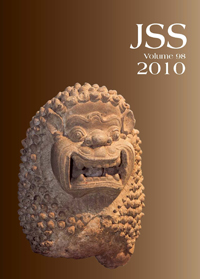Iconographical issues in the archeology of Wat Phra Men, Nakhon Pathom
Main Article Content
Abstract
Wat Phra Men, an important temple site at Nakhon Pathom in the Central Plains of Thailand from around the 7th to 8th centuries CE, is re-examined for the diverse conclusions that can be drawn from iconographical study of its Buddha images. Four or five colossal images, seated in the so-called “European fashion”, are reputed to have originated here although they are today displayed in different temples and museums. The history of the discoveries and restorations at the site is reviewed. While the precise nature and original appearance of the monument remain a mystery, the iconographical significance of the images lies in different possible interpretations according to the Buddhist traditions that were practiced here. The nature of Buddhism in the Dvāravatī period was evidently very heterogeneous; esoteric forms of Mahāyāna Buddhism may have evolved at Wat Phra Men in Theravāda guise. The results of this re-examination should hold implications for other Buddhist sites in Nakhon Pathom and neighboring provinces.


